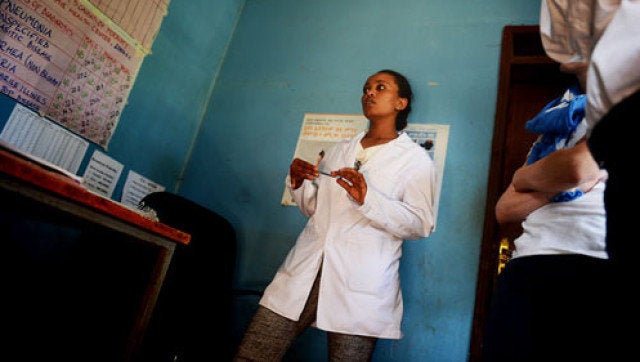
Gabrielle Blair is a designer, mother of six, and the author of the blog, Design Mom. She is traveling in Ethiopia with ONE this October. This piece, originally published on Design Mom, is part of our ongoing coverage of the trip.
By Gabrielle.
I've been home from Ethiopia for a couple of weeks now and I'm still trying to process everything I learned, everything I saw. This morning, I was on the phone with my friend Erin and she asked me about this particular Instagram I published during my trip. She wanted to know more about the Health Workers I mentioned. So I promised her I'd share everything I knew about the program here.
The health needs in Ethiopia are great, so the program is ambitious. With assistance from USAID, Ethiopia created an army of Health Extension Workers. These workers are assigned to every village and community in the country.
The program is pretty amazing, but the stroke of genius is that all 30,000 of the Health Extension Workers are women.
You may be imagining 30,000 doctors, and for most villagers, these workers are the closest thing to a doctor they have access to. But the Health Extension Workers are not doctors. They are not nurses either. Their training is very specific. They have the skills to recognize and prevent the health problems that most often affect the citizens of Ethiopia. Conditions like malaria, dehydration and malnutrition.
They are trained to teach local mothers about healthy nutrition for their babies. They are trained to discreetly inquire about fistula. Additionally they are trained to administer birth control at a couple or woman's request (all kinds, even IUDs and shots).
We visited two field clinics. One was bigger and comprised of several small buildings -- very rustic. But I was amazed at what they accomplished with the resources available to them. The bigger facility could see patients and even deliver babies (one was delivered 2 hours before we arrived). It could administer HIV medicine.
When you picture this facility, don't think of your doctor's office or your hospital. There are no fresh linens to wrap the babies in. There are no washing machines to clean the linens, if the linens existed. We asked what the most pressing need was right now, and the Health Extension Worker answered that the blood pressure cuff was faulty. Friends, the blood pressure cuff is pretty much the only technology they are using at this facility. If someone came to this field clinic and was in need of surgery (like a c-section), I have no idea what happens.
But the charts you see on the wall? They are careful records of every infection and sickness the facility has seen, how the disease was treated, and what the results were. And the charts look good. The numbers are improving. Because the program is working. And as rustic as this facility is, it's still a huge improvement over the non-existent facility of a few years ago.
This gentleman, who looked about 23 years old, is not a Health Extension Worker (as I mentioned, they are all women). But he is the director of this clinic. I was told his training was similar to a Nurse Practitioner.
At each of the field clinics we visited, there was a mud hut on site. A typical example of the village architecture. These are used as models for teaching proper hygiene and nutrition at home. What does this mean? It means using the model home to show that the farm animals need to have sleeping quarters that are separate than the family's. It means showing how to hang and use a mosquito net.
These are pictures from a smaller field clinic (the one pictured at top). It was essentially a two-room mud hut. You know those plastic, plaid shopping bags? The mud walls were lined in the material of those bags. Again, the walls were covered in charts.
The two Heath Extension Workers that man this clinic were proud of their work. With good reason! This is how they spend their day: four hours in the clinic, then the rest of the day spent going door-to-door in their communities. Each worker is assigned 500(!) families. They visit these families looking for health problems, teaching parents about disease prevention, and generally assessing the health needs in the community.
And this is why it's so great that all 30,000 workers are women. In Ethiopia, females have long been lower-class citizens. What better way to start reversing that harmful cultural practice than by hiring and empowering 30,000 women and placing them in influential positions in communities throughout the country. Amazing! I get so emotional just thinking about it, about what this demonstrates. It's a big deal.
This is one of the mothers in their community.
And these are some of the kids. Oh man I loved hanging out with those kids. I couldn't speak their language, so we communicated with high-five, down-low, too slow.
Images on this post by Karen Walrond, myself, and Michelle Pannell.
If you've already joined ONE, thank you from the bottom of my heart. If you want to do more, please consider sharing these reports on Twitter, Facebook, Pinterest or your own blog. I can't tell you how much I appreciate the support.
Earlier this month, I spent a week in Ethiopia at the kind invitation and expense of The ONE Campaign, a nonpartisan, advocacy organization dedicated to the fight against extreme poverty and malnutrition, particularly in Africa. ONE works to convince governments to invest in smart programs that save lives. While there, I was with a group of parenting bloggers to observe how the organizations for which ONE advocates are effecting real change in Ethiopia.
